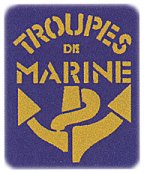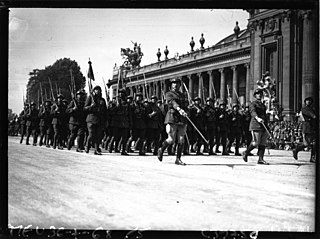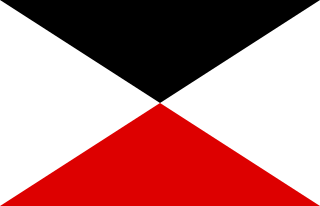
The 49th Infantry Division was an infantry division of the British Army. The division fought in the First World War in the trenches of the Western Front, in the fields of France and Flanders. During the Second World War, the division fought in the Norwegian Campaign and in North-western Europe. After the Second World War, it was disbanded in 1946, then reformed in 1947. It remained with Northern Command until finally disbanded in 1967.
The Panzerkorps Großdeutschland was a German panzer corps in the Wehrmacht which saw action on the Eastern Front in 1944/1945 during World War II.

The Troupes de Marine or TDM, sometimes simply referred to as "French Marines" in English, are one of the major components of the French Army and comprise several specialties: infantry, airborne, armoured cavalry, artillery, engineering, and transmissions (signals). Characterized by their fundamental vocation for service beyond the seas, including in French overseas territories and, formerly, in French colonies, the Marines have taken part in all French military campaigns since the corps' foundation, both on home soil and in theaters of operations around the world. They are stationed in Metropolitan France, in many French overseas departments and territories, as well as in Africa.

The 55th Infantry Division was a French Army formation during World War I and World War II.
The 41st Infantry Division was a French Army formation during World War I and World War II.
The 60th Infantry Division was a French Army formation during World War I and World War II.
The 61st Infantry Division was a French Army formation during World War I and World War II
The 101st Infantry Division was a Territorial division during World War I, and a Fortress division during World War II.
The 32nd Infantry Division was a French Army formation during World War I and World War II.

The 8th Infantry Division was a French Army formation during World War I, World War II and the Cold War. It was dissolved in 1993.
The 22nd Infantry Division was a French Army formation during World War I and World War II.

The 3rd Colonial Infantry Division was a division of the French Marine Forces, comprising mostly French citizen troops.

The Fortified Sector of Montmédy was the French military organisation that in 1940 controlled the section of the Maginot Line between Sedan and Longuyon, a distance of about 60 kilometres (37 mi). The sector was not as strongly defended as other sections of the Maginot Line, facing the southern Ardennes region of Belgium. Large portions of the Montmédy sector were defended by fortified houses, blockhouses or casemates. The sector includes only four ouvrages of the type found in stronger sections of the Line. The weakly defended area in front of Sedan was the scene of a major breakthrough by German forces in the opening of the Battle of France. This was followed by a German assault on the Maginot Ouvrage La Ferté, which killed the entire garrison, the only such event on the Maginot Line.

The Fortified Sector of the Vosges was the French military organization that in 1940 controlled the section of the Maginot Line at the northern end of the Vosges Mountains in northeastern France. The sector was bordered to the west by the Fortified Sector of Rohrbach and to the east by the Fortified Sector of Haguenau. The sector featured two gros ouvrages mounting heavy artillery at either end of the sector and one petit ouvrage mounting infantry weapons, linked by a line of casemates. The sector was attacked in 1940 by German forces in the Battle of France. German forces penetrated the casemate line and moved behind French lines. Despite the withdrawal of the mobile forces that supported the fixed fortifications, the three ouvrages successfully fended off German assaults before the Second Armistice at Compiègne, but were unable to hinder German activities to their south. The positions and their garrisons finally surrendered on 1 July 1940. Following the war several positions were reactivated for use during the Cold War. One position, Ouvrage Four-à-Chaux, is open to the public and may be visited.
The Fortified Sector of the Sarre was the French military organization that in 1940 controlled the section of the Maginot Line on either side of the Sarre river. The sector's defenses relied primarily on a system of inundations that could be created by fortified dikes and regulating weirs, backed by blockhouses. Weakly defended compared with other sections of the Maginot Line, the sector received a measure of attention and funding from the mid-1930s when the formerly demilitarized Saarland was reintegrated into Germany. However, with a single petit ouvrage it remained a weak point in the Line. In 1940 the Sarre sector was attacked by German forces in the Battle of France. The inundations were only partly successful, and German forces were able to pierce the Maginot Line at the Sarre, allowing German divisions to move behind the main French line.

The IX Army Corps / IX AK was a corps level command of the Prussian and German Armies before and during World War I.

The 15th Infantry Division was an infantry division of the French Army originally formed after the end of the Franco-Prussian War that fought in World War I. It fought in World War II as the 15th Motorized Infantry Division, under the command of Alphonse Juin, surrendering during the Battle of France.

The Fortified Section of Savoy(Secteur fortifié de la Savoie) was the French military organization that in 1940 controlled the section of the Alpine Line portion of the Maginot Line facing Italy in the Savoy region. The sector constituted part of the Alpine Line portion of the Maginot Line, between the Defensive Sector of the Rhône to the north, and the Fortified Sector of the Dauphiné to the south. The works combined a number of pre-1914 fortifications with Maginot-style ouvrages, with many forward-positioned cavern-style frontier stations or avant-postes that proved effective in holding invading forces near the order.
156th Infantry Division was an infantry division of the French Army during the First World War. It was deployed overseas, seeing action during the Gallipoli campaign, and thereafter on the Salonika front, fighting alongside British troops in both theatres of war. It was sent to the Crimea in December 1918 as part of the Army of the Danube.

The 2nd Colonial Infantry Division was a French Army formation which fought in World War I and World War II.










